A (Very) Partial Pictorial History of Troglodytes
Since last week we looked at lizard men, I thought it would make sense to examine troglodytes next, since they're both humanoid reptilian monsters. There are, of course, lots of differences between them, starting with their alignment – troglodytes are Chaotic Evil, while lizard men are Neutral – I can nevertheless easily imagine someone confusing the two. With that in mind, how did TSR era Dungeons & Dragons visually distinguish between them?
The earliest illustrations I can find of troglodytes come from the AD&D Monster Manual (1977), both by Dave Sutherland. Sutherland gives trogs a much shorter snout and a large crest on their heads. These are both features that can be found in most of the depictions that follow.
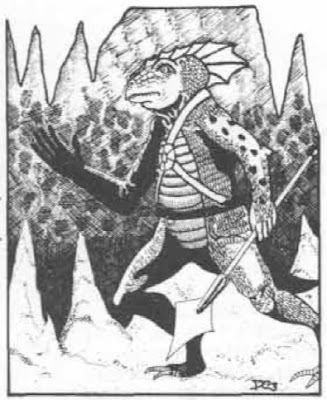 The second illustration from the Monster Manual gives us a better look at these monsters' legs, as well as their scaly skin. Both pieces of art hide the troglodyte's tail in shadow, but it is there, if you look carefully.
The second illustration from the Monster Manual gives us a better look at these monsters' legs, as well as their scaly skin. Both pieces of art hide the troglodyte's tail in shadow, but it is there, if you look carefully.
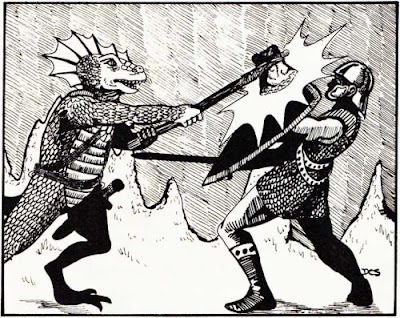 Sutherland provides two additional depictions of trogs on the front and back covers of the original 1978 release of the module Descent into the Depths of the Earth. Here's the front cover, which shows them as looking little different from those in the Monster Manual.
Sutherland provides two additional depictions of trogs on the front and back covers of the original 1978 release of the module Descent into the Depths of the Earth. Here's the front cover, which shows them as looking little different from those in the Monster Manual.
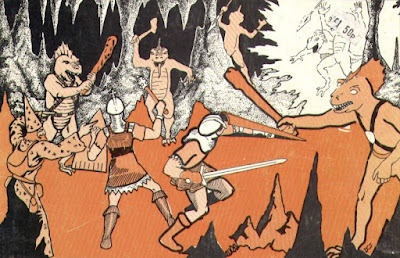 The back cover of the module is interesting, because it depicts not only a troglodyte, but also an exceptionally long-nosed troll and a bugbear.
The back cover of the module is interesting, because it depicts not only a troglodyte, but also an exceptionally long-nosed troll and a bugbear.
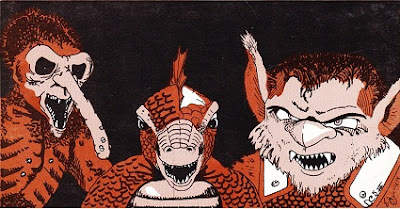 A troglodyte next appears in the Tom Moldvay D&D Basic rulebook (1981), as drawn by Bill Willingham. Willingham's take on the monster is clearly inspired by Sutherland's, but with a few new elements. First, ridges or frills like the head crest also appear on both arms. Also, the monster's face looks a bit more fishy or amphibian, with large, blank eyes and a mouth that reminds me of a catfish's.
A troglodyte next appears in the Tom Moldvay D&D Basic rulebook (1981), as drawn by Bill Willingham. Willingham's take on the monster is clearly inspired by Sutherland's, but with a few new elements. First, ridges or frills like the head crest also appear on both arms. Also, the monster's face looks a bit more fishy or amphibian, with large, blank eyes and a mouth that reminds me of a catfish's.
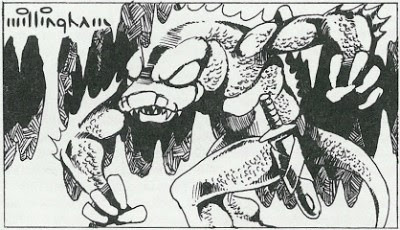 In 1982, as part of the AD&D Monster Cards, we get Jeff Dee's nifty take on troglodytes. Once again, it's broadly consonant with Sutherland's original, but Dee's version has a slightly more dinosaur-like appearance. Coupled with the stone axe it's holding, Dee gives the trogs a kind of Lost World flavor that I really like.
In 1982, as part of the AD&D Monster Cards, we get Jeff Dee's nifty take on troglodytes. Once again, it's broadly consonant with Sutherland's original, but Dee's version has a slightly more dinosaur-like appearance. Coupled with the stone axe it's holding, Dee gives the trogs a kind of Lost World flavor that I really like.
 The same year, we get Jeff Easley's version in the AD&D module The Lost Caverns of Tsojcanth. Though recognizable because of their head crests, these troglodytes look a bit fishy in appearance. Take note of their eyes and mouths, not to mention their scales, which strike me as more piscine than reptilian in appearance.
The same year, we get Jeff Easley's version in the AD&D module The Lost Caverns of Tsojcanth. Though recognizable because of their head crests, these troglodytes look a bit fishy in appearance. Take note of their eyes and mouths, not to mention their scales, which strike me as more piscine than reptilian in appearance.
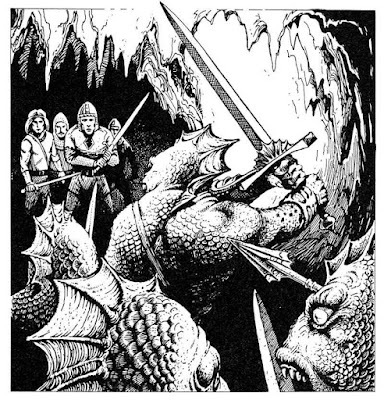 1982 seems to have been a big year for troglodyte illustrations, because we get one by Jim Holloway in Against the Cult of the Reptile God. Though we don't get to see the entirety of the monster, what we do see suggests that it's closer to Sutherland than any of the other artists we've examined. It's also a return to a more clearly reptilian depiction, as you can see from its mouth and eyes.
1982 seems to have been a big year for troglodyte illustrations, because we get one by Jim Holloway in Against the Cult of the Reptile God. Though we don't get to see the entirety of the monster, what we do see suggests that it's closer to Sutherland than any of the other artists we've examined. It's also a return to a more clearly reptilian depiction, as you can see from its mouth and eyes.

In 1985, Citadel Miniatures released a troglodyte miniature that's also very reptilian in appearance. If you look carefully, you can see not only its crocodile-like scales but also its cranial ridges (which are smaller).
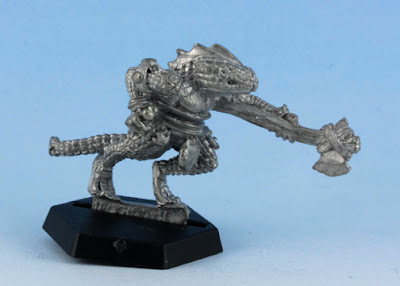
Two years later, in 1987, Ral Partha gained the AD&D miniatures license and released its own version of the troglodyte. Here's a trio of them, which, to my eyes anyway, don't look all that different than traditional depictions of lizard men. They do have the cranial ridges at least, though, like Citadel before them, they're much smaller than in previous depictions of them.
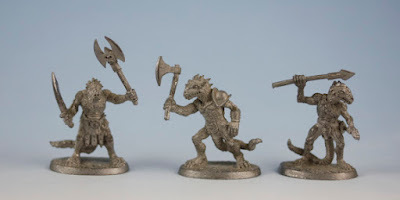 AD&D Second Edition's Monstrous Compendium (1989) saved the troglodyte for its second release (MC2), which suggests that TSR didn't see troglodytes as being as important as lizard men, who appeared earlier. True or not, we get this absolutely atrocious illustration of them (by Daniel Horne) that looks like an anthropomorphic horny toad with some serious dental problems. Yikes!
AD&D Second Edition's Monstrous Compendium (1989) saved the troglodyte for its second release (MC2), which suggests that TSR didn't see troglodytes as being as important as lizard men, who appeared earlier. True or not, we get this absolutely atrocious illustration of them (by Daniel Horne) that looks like an anthropomorphic horny toad with some serious dental problems. Yikes!
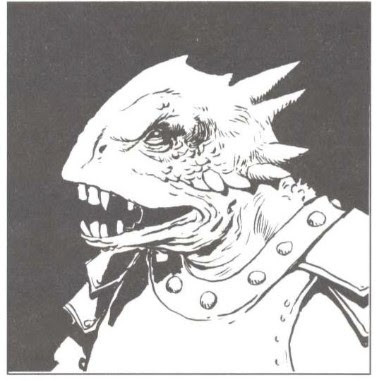 Then, in 1993, Tony DiTerlizzi provides this illustration for the Monstrous Manual. It's something of a break with previous versions. DiTerlizzi opts for a newt-like, amphibian appearance rather than a reptilian one.
Then, in 1993, Tony DiTerlizzi provides this illustration for the Monstrous Manual. It's something of a break with previous versions. DiTerlizzi opts for a newt-like, amphibian appearance rather than a reptilian one.
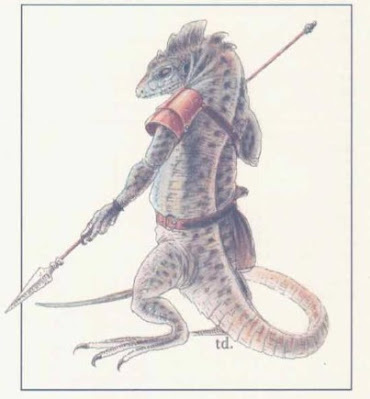 Reviewing this sampling of troglodyte artwork from the TSR era of Dungeons & Dragons, I'm struck by two things. First, there is some degree of consistency in the depiction of these monsters, with most artists looking to Dave Sutherland's Monster Manual art as a foundation. Second, each post-Sutherland illustrator (with the possible exception of Holloway) put his own spin on the troglodytes by giving them some fish-like or amphibian characteristics. I can certainly understand why they might do this, since it's a good way to distinguish trogs from lizard men (and other reptile men) visually. At the same time, I think this variability contributes to rather than diminishes the conflation of troglodytes and lizard men, which likely explains why my vision of troglodytes is very close to that of Sutherland.
Reviewing this sampling of troglodyte artwork from the TSR era of Dungeons & Dragons, I'm struck by two things. First, there is some degree of consistency in the depiction of these monsters, with most artists looking to Dave Sutherland's Monster Manual art as a foundation. Second, each post-Sutherland illustrator (with the possible exception of Holloway) put his own spin on the troglodytes by giving them some fish-like or amphibian characteristics. I can certainly understand why they might do this, since it's a good way to distinguish trogs from lizard men (and other reptile men) visually. At the same time, I think this variability contributes to rather than diminishes the conflation of troglodytes and lizard men, which likely explains why my vision of troglodytes is very close to that of Sutherland.How about you? How do you view troglodytes?
Published on August 11, 2024 21:00
No comments have been added yet.
James Maliszewski's Blog
- James Maliszewski's profile
- 3 followers
James Maliszewski isn't a Goodreads Author
(yet),
but they
do have a blog,
so here are some recent posts imported from
their feed.



